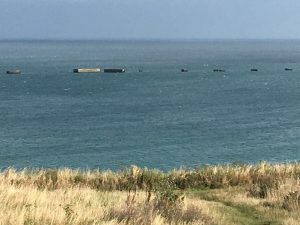Not surprisingly, this part of France is notable for it’s place in the history books. Also for it’s Calvados. What I noted today in my tour of the various battle and monument sites is the degree to which the the invasion is memorialized. At most places, both large and small, there are flags of the Allied countries waving on tall flagpoles. And there’s signage at every intersection directing people along the D-Day “trail”.
The town that I’m staying in is at the east end of the beaches that were used as landing sights on June 6, 1944 — Sword Beach — where several British forces came in. Today I drove along the coast road, taking me past Juno (Canadian landing beach), Gold (more British), and of course Omaha and Utah, best known to the Americans for the infantry, airborne, rangers, and navy which stormed the beaches there. It’s a very long set of beaches — over 50 miles — something that I’m not sure we can visualize in the movies. But driving it you definitely get the full sense of the amount of land that needed to be taken by the Allied forces, and just how much territory the Germans were holding, and had dug into. I’m reading the DDay book by Ambrose, and while I knew some of the facts of the invasion, seeing the places in person, along with photographs and maps takes the experience to an entirely different, and much more emotional level.
I visited Arromanches where the remains of the artificial Mulberry Harbor still sit in the sea. The brainchild of Churchill, who argued that in order to bring to shore additional men and materiel for the war effort a harbor was necessary, the concrete caissons were towed across the Channel and sunk into the sand bed below. Then wharves and other floating piers were anchored, allowing more than 2 million soldiers, 500,000 vehicles and 3 million tons of supplies to come into Normandy to support the invasion.
Then to the Overlord Museum, which I didn’t love. There were re-enactment scenes and loads of tanks and Jeeps and other vehicles from the War. And since war in general sucks, I didn’t need to see the romancing of the equipment. The only interesting note is how much of the manufacturing output from the US and the UK in the years leading up to DDay was dedicated to equipment for it. Tens, if not hundreds, of thousands of vehicles from all the major companies, as well as some new scrappy inventors (Higgins Boats as an example) were produced and shipped overseas. A major undertaking and demonstration of America at it’s best.
From there to the American Cemetary and Memorial. There are 9,387 American servicemen buried there, most of whom died during the Battle for Normandy. And there are 1,557 names on the wall of the missing. Over 156,000 Allied troops landed in Normandy on June 6, and over 9,000 were killed that day. (Which was a lower casualty rate than had been expected). The crosses go on forever, and there’s a Chapel at one end and the Memorial at the other. It’s a somber place.
Lastly, Pointe du Hoc, the only place where you can still see some remains of the battle in the landscape. It was here, just above Utah Beach that the Rangers had to climb rope ladders up the side of 100 ft cliffs and disable the Germany positions on the top. When they arrived they discovered that the big guns that they thought were there were just camouflaged sticks, so while not under immediate fire, the battalion had to find where the guns had been hidden inland and take them out in order to protect the infantry on the beach. They took heavy losses; of the 225 men who scaled the cliff, only 90 remained when replacements arrived 2 days later. But had they not succeeded, the Allies would not have gained a foothold in Normandy. The landscape is dotted with craters from the bombardment, as well as what’s left of the German bunkers, which the Rangers used for command posts and places for the wounded. It was strange to see children running around the mounds and pits knowing that many died there.
How’s all that for uplifting?
Then a drive in the Normandy countryside, through tiny villages of creamy stone houses with pale green or blue shutters, set right up against the road. Every town has a church, with the steeple visible from the distance, amazing to see since so many were bombed and then rebuilt. I passed by fields of wheat and corn, with pretty brown or white cows and sheep grazing, all of which helped to bring me back to the beauty of present day Normandy. Which wouldn’t be as it is if it weren’t for all those men who wore the uniforms in 1944.
And that was my day of WWII.


















The white crosses seem to go on forever!